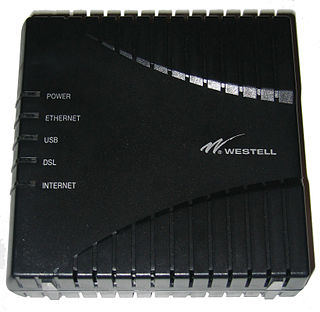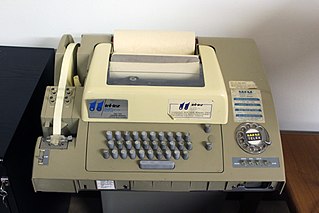Related Research Articles

Integrated Services Digital Network (ISDN) is a set of communication standards for simultaneous digital transmission of voice, video, data, and other network services over the digitalised circuits of the public switched telephone network. Work on the standard began in 1980 at Bell Labs and was formally standardized in 1988 in the CCITT "Red Book". By the time the standard was released, newer networking systems with much greater speeds were available, and ISDN saw relatively little uptake in the wider market. One estimate suggests ISDN use peaked at a worldwide total of 25 million subscribers at a time when 1.3 billion analog lines were in use. ISDN has largely been replaced with digital subscriber line (DSL) systems of much higher performance.

The 5ESS Switching System is a Class 5 telephone electronic switching system developed by Western Electric for the American Telephone and Telegraph Company (AT&T) and the Bell System in the United States. It came into service in 1982 and the last unit was produced in 2003.

In telecommunications and computer networking, multiplexing is a method by which multiple analog or digital signals are combined into one signal over a shared medium. The aim is to share a scarce resource – a physical transmission medium. For example, in telecommunications, several telephone calls may be carried using one wire. Multiplexing originated in telegraphy in the 1870s, and is now widely applied in communications. In telephony, George Owen Squier is credited with the development of telephone carrier multiplexing in 1910.

Time-division multiplexing (TDM) is a method of transmitting and receiving independent signals over a common signal path by means of synchronized switches at each end of the transmission line so that each signal appears on the line only a fraction of time according to agreed rules, e.g. with each transmitter working in turn. It can be used when the bit rate of the transmission medium exceeds that of the signal to be transmitted. This form of signal multiplexing was developed in telecommunications for telegraphy systems in the late 19th century but found its most common application in digital telephony in the second half of the 20th century.
Telephony is the field of technology involving the development, application, and deployment of telecommunications services for the purpose of electronic transmission of voice, fax, or data, between distant parties. The history of telephony is intimately linked to the invention and development of the telephone.
Telephone number mapping is a system of unifying the international telephone number system of the public switched telephone network with the Internet addressing and identification name spaces. Internationally, telephone numbers are systematically organized by the E.164 standard, while the Internet uses the Domain Name System (DNS) for linking domain names to IP addresses and other resource information. Telephone number mapping systems provide facilities to determine applicable Internet communications servers responsible for servicing a given telephone number using DNS queries.
A telecommunication circuit is a path in a telecommunications network used to transmit information. Circuits have evolved from generally being built on physical connections between individual hardware cables, as in an analog phone switch, to virtual circuits established over packet switching networks.
Semi-active radar homing (SARH) is a common type of missile guidance system, perhaps the most common type for longer-range air-to-air and surface-to-air missile systems. The name refers to the fact that the missile itself is only a passive detector of a radar signal—provided by an external ("offboard") source—as it reflects off the target. Semi-active missile systems use bistatic continuous-wave radar.
A softswitch is a call-switching node in a telecommunications network, based not on the specialized switching hardware of the traditional telephone exchange, but implemented in software running on a general-purpose computing platform. Like its traditional counterparts it connects telephone calls between subscribers or other switching systems across a telecommunication network. Often a softswitch is implemented to switch calls using voice over IP (VoIP) technologies, but hybrid systems exist.
In electrical engineering, a stepping switch or stepping relay, also known as a uniselector, is an electromechanical device that switches an input signal path to one of several possible output paths, directed by a train of electrical pulses.
Beam-riding, also known as Line-Of-Sight Beam Riding (LOSBR), beam guidance or radar beam riding is a technique of directing a missile to its target by means of radar or a laser beam. The name refers to the way the missile flies down the guidance beam, which is aimed at the target. It is one of the simplest guidance systems and was widely used on early missile systems, however it had a number of disadvantages for long-range targeting and is now found typically only in short-range roles.
A beyond-visual-range missile is an air-to-air missile that is capable of engaging at ranges of 20 nmi (37 km) or beyond. This range has been achieved using dual pulse rocket motors or booster rocket motor and ramjet sustainer motor.
Track-via-missile or TVM refers to a missile guidance technique which combines features of semi-active radar homing (SARH) and radio command guidance. This avoids the problems with terminal accuracy normally seen by command guided missiles, especially at long range. It has been used on a number of long-range surface-to-air missiles (SAMs) including the MIM-104 Patriot.

Active radar homing (ARH) is a missile guidance method in which a missile contains a radar transceiver and the electronics necessary for it to find and track its target autonomously. The NATO brevity code for an air-to-air active radar homing missile launch is fox three.

A digital subscriber line (DSL) modem is a device used to connect a computer or router to a telephone line which provides the digital subscriber line (DSL) service for connection to the Internet, which is often called DSL broadband. The modem connects to a single computer or router, through an Ethernet port, USB port, or is installed in a computer PCI slot.

AT&T Merlin is a corporate telephone system by American Telephone and Telegraph (AT&T) that was introduced in late 1983, when it was branded American Bell Merlin. After the breakup of AT&T in 1984, it was rebranded and later also supplied by Lucent and Avaya.
Homing may refer to:

The RIM-67 Standard ER (SM-1ER/SM-2ER) is an extended range surface-to-air missile (SAM) with a secondary anti-ship capability, originally developed for the United States Navy (USN). The RIM-67 was developed as a replacement for the RIM-8 Talos, a 1950s system deployed on a variety of USN ships, and eventually replaced the RIM-2 Terrier as well, since it was of a similar size and fitted existing Terrier launchers and magazines. The RIM-66 Standard MR was essentially the same missile without the booster stage, designed to replace the RIM-24 Tartar. The RIM-66/67 series thus became the US Navy's universal SAM system, hence the designation "Standard Missile".

A telephone exchange, also known as a telephone switch or central office, is a crucial component in the public switched telephone network (PSTN) or large enterprise telecommunications systems. It facilitates the interconnection of telephone subscriber lines or digital system virtual circuits, enabling telephone calls between subscribers.

Telex is a telecommunication service that provides text-based message exchange over the circuits of the public switched telephone network or by private lines. The technology operates on switched station-to-station basis with teleprinter devices at the receiving and sending locations. Telex was a major method of sending text messages electronically between businesses in the post–World War II period. Its usage went into decline as the fax machine grew in popularity in the 1980s.
References
![]() This article incorporates public domain material from Federal Standard 1037C. General Services Administration. Archived from the original on 2022-01-22. (in support of MIL-STD-188).
This article incorporates public domain material from Federal Standard 1037C. General Services Administration. Archived from the original on 2022-01-22. (in support of MIL-STD-188).